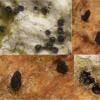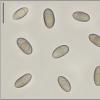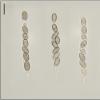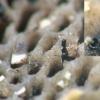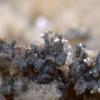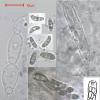
18-12-2025 17:23
 Bruno Coué
Bruno Coué
Bonjour,je serais heureux d'avoir votre avis sur c

18-12-2025 21:17
Pol DebaenstThe identification took me to Byssonectria deformi

18-12-2025 18:07
Margot en Geert VullingsThese plumes were found on rotten wood.They strong

17-12-2025 18:35
 Michel Hairaud
Michel Hairaud
Bonjour à tous/Hi to everyone I am passing along

15-12-2025 15:48
 Danny Newman
Danny Newman
Melanospora cf. lagenaria on old, rotting, fallen

15-12-2025 15:54
 Johan Boonefaes
Johan Boonefaes
Unknown anamorph found on the ground in coastal sa

15-12-2025 21:11
 Hardware Tony
Hardware Tony
Small clavate hairs, negative croziers and IKI bb

15-12-2025 07:09
 Danny Newman
Danny Newman
indet. Rutstroemiaceae sp. on unk. fallen leavesMc
Pyrenomycet on Pycnoporus
Gernot Friebes,
01-11-2010 16:47
this summer I found an unitunicate pyrenomycet on an old fruitbody of Pycnoporus cinnabarinus. I have no idea where to search this fungus. The ascomata are black with a long neck and the perithecia are immersed. The spores measure 7,5-10 x 4-5 µm, are smooth, without a germ slit and with one ore two oil drops inside. The asci are unitunicate, uni- or slightly biseriate and measure 65-75 x 7-9 µm. I didn't see any paraphyses.
Best wishes and many thanks
Gernot
Martin Bemmann,
01-11-2010 16:59

Re:Pyrenomycet on Pycnoporus
Hallo Gernot,
hast Du es mal bei mal Helminthosphaeria probiert?
http://www.cybertruffle.org.uk/cyberliber/59350/0089/001/0141.htm
Herzlich
Martin
hast Du es mal bei mal Helminthosphaeria probiert?
http://www.cybertruffle.org.uk/cyberliber/59350/0089/001/0141.htm
Herzlich
Martin
Gernot Friebes,
01-11-2010 17:27
Re:Pyrenomycet on Pycnoporus
Hi Martin,
thank you but Helmintosphaeria should have setae which my find doesn't have. Also, I don't think that species in Helmintosphaeria form such long ostioles but maybe I'm wrong.
Best wishes,
Gernot
thank you but Helmintosphaeria should have setae which my find doesn't have. Also, I don't think that species in Helmintosphaeria form such long ostioles but maybe I'm wrong.
Best wishes,
Gernot
Jacques Fournier,
01-11-2010 17:36

Re:Pyrenomycet on Pycnoporus
Hi gernot,
I think your fungus belongs to Ceratostomella as revised by Réblova in 2006 (Mycologia 98). The immersed, long beaked ascomata and one-celled grey brown ascospores fit well the genus.
Ceratostomella pyrenaica occurs on wood and on old polypores as well, but its spores are more slender and differently shaped.
Ceratostomella rhynchophora is also a possible match but its spores are a bit shorter and have a minute pore at both ends. You should come back to your fungus and check whether it fits any of those two species.
Good luck!
Jacques
I think your fungus belongs to Ceratostomella as revised by Réblova in 2006 (Mycologia 98). The immersed, long beaked ascomata and one-celled grey brown ascospores fit well the genus.
Ceratostomella pyrenaica occurs on wood and on old polypores as well, but its spores are more slender and differently shaped.
Ceratostomella rhynchophora is also a possible match but its spores are a bit shorter and have a minute pore at both ends. You should come back to your fungus and check whether it fits any of those two species.
Good luck!
Jacques
Uwe Lindemann,
01-11-2010 19:15
Re:Pyrenomycet on Pycnoporus
Hello Gernot,
due to your posting and Jacques' reference to the article by Reblova I remembered a find I made in 2008 at Berlin (Plänter Wald) which is until now not determinated. Unfortunately, I have no material of this find. Therefore I had only some sparse notes and a few (very) bad microphotos and a bad drawing inside the microphoto (see below).
Here are my data:
Spores light brown to light greybrown, small elliptical, in side view sligthly curved, 7-9 x 2,5-3 µm, with two or three oildrops (in IKI with a very slightly amyloid reaction)
Asci 35-40 x 8-10 µm, IKI-
Texture and “hairs” not examined.
Substrate: on old, wet and rotten Trametes gibbosa (at Fagus sylvatica). Trametes gibbosa is blueing in some areas (due to this fungus?).
If I study the article by Reblova, it takes me to Ceratostomella pyrenaica. Can it be possible? What do you think, Jacques?
Best, Uwe
due to your posting and Jacques' reference to the article by Reblova I remembered a find I made in 2008 at Berlin (Plänter Wald) which is until now not determinated. Unfortunately, I have no material of this find. Therefore I had only some sparse notes and a few (very) bad microphotos and a bad drawing inside the microphoto (see below).
Here are my data:
Spores light brown to light greybrown, small elliptical, in side view sligthly curved, 7-9 x 2,5-3 µm, with two or three oildrops (in IKI with a very slightly amyloid reaction)
Asci 35-40 x 8-10 µm, IKI-
Texture and “hairs” not examined.
Substrate: on old, wet and rotten Trametes gibbosa (at Fagus sylvatica). Trametes gibbosa is blueing in some areas (due to this fungus?).
If I study the article by Reblova, it takes me to Ceratostomella pyrenaica. Can it be possible? What do you think, Jacques?
Best, Uwe
Jacques Fournier,
01-11-2010 20:11

Re:Pyrenomycet on Pycnoporus
Hi Uwe,
I agree with you this is much like C. pyrenaica. Your photos, even not very sharp, illustrate well the different shape of spores as compared with Gernot's ones.
Gernot, at least you know what your fungus is not!
Jacques
I agree with you this is much like C. pyrenaica. Your photos, even not very sharp, illustrate well the different shape of spores as compared with Gernot's ones.
Gernot, at least you know what your fungus is not!
Jacques
Gernot Friebes,
01-11-2010 21:05
Re:Pyrenomycet on Pycnoporus
Hi Jacques and Uwe,
sure, Ceratostomella! Thanks, I totally forgot about this genus. But now it's difficult because C. pyrenaica clearly is a different species and C. rhynchophora should have shorter spores. Except of the size of the spores everything fits for C. rhynchophora, I think I have even seen the pores at the end of some spores. Very interesting...
Best wishes and thanks again,
Gernot
sure, Ceratostomella! Thanks, I totally forgot about this genus. But now it's difficult because C. pyrenaica clearly is a different species and C. rhynchophora should have shorter spores. Except of the size of the spores everything fits for C. rhynchophora, I think I have even seen the pores at the end of some spores. Very interesting...
Best wishes and thanks again,
Gernot
Uwe Lindemann,
01-11-2010 23:10
Re:Pyrenomycet on Pycnoporus
Hi Gernot,
thank you for your posting!
Hi Jacques,
thank you for your confirmation!
Best, Uwe
thank you for your posting!
Hi Jacques,
thank you for your confirmation!
Best, Uwe
Alain GARDIENNET,
16-12-2010 00:24
Re:Pyrenomycet on Pycnoporus
Hi friends,
Have you looked around the genus Xylomelasma ?
Jacques, you know X. sordida, I believe ? Is it possible ?
Alain
Have you looked around the genus Xylomelasma ?
Jacques, you know X. sordida, I believe ? Is it possible ?
Alain
NC NC,
16-12-2010 07:31
Re:Pyrenomycet on Pycnoporus
Hi Alain,
thank you very much for your suggestion, I think that Xylomelasma sordida fits even better to my fungus than C. rhynchophora in size of ascospores, big oil drop inside the spores and arrangement in the ascus.
Best wishes,
Gernot
thank you very much for your suggestion, I think that Xylomelasma sordida fits even better to my fungus than C. rhynchophora in size of ascospores, big oil drop inside the spores and arrangement in the ascus.
Best wishes,
Gernot
Jacques Fournier,
16-12-2010 17:22

Re:Pyrenomycet on Pycnoporus
I fully agree with Alain, Xylomelasma is a much better match because of the cylindric asci with uniseriate spores, as it is well illustrated in Gernot's photos, and X. sordida very plausible, though the substrate is unusual.
Great forum !
Jacques
Great forum !
Jacques
NC NC,
16-12-2010 18:27
Re:Pyrenomycet on Pycnoporus
Yes, thank you very much, Alain and Jacques! Also the size of the spores and the big oil drop inside them fit better for Xylomelasma according to Réblova's work. It is very interesting to see how these species can grow both on wood and old polypores.
Best wishes,
Gernot
Best wishes,
Gernot
Gernot Friebes,
16-12-2010 18:28
Re:Pyrenomycet on Pycnoporus
Yes, thank you very much, Alain and Jacques! Also the size of the spores and the big oil drop inside them fit better for Xylomelasma according to Réblova's work. It is very interesting to see how these species can grow both on wood and old polypores.
Best wishes,
Gernot
Best wishes,
Gernot

